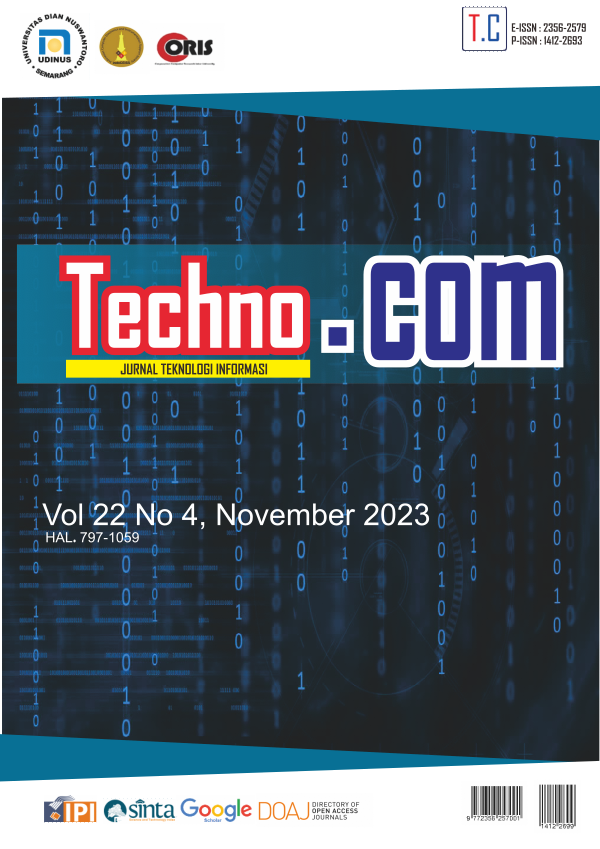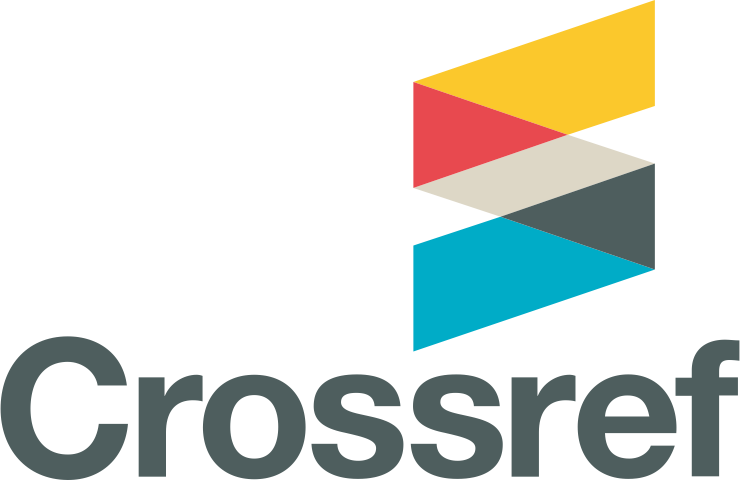Klasifikasi Status Drop Out Mahasiswa Menggunakan Naïve Bayes dengan Seleksi Fitur Information Gain
DOI:
https://doi.org/10.33633/tc.v22i4.9004Keywords:
drop out, Information Gain, Naive Bayes, klasifikasiAbstract
Salah satu masalah dalam perguruan tinggi adalah kasus drop out. Banyaknya mahasiswa yang mengalami drop out merupakan salah satu indikator yang mempengaruhi kualitas pembelajaran dan akreditasi yang sangat penting untuk keberlangsungan suatu institusi. Penelitian ini menerapkan algoritma Naive Bayes dan algoritma seleksi fitur Information Gain untuk melakukan klasifikasi mahasiswa drop out. Hasil penelitian menunjukkan bahwa dua fitur yang berpengaruh paling signifikan terhadap klasifikasi mahasiswa drop out adalah jumlah SKS yang ditempuh dan nilai IPS pada semester 4. Temuan ini menunjukkan bahwa aspek akademik yang terkait dengan perkembangan studi mahasiswa berpengaruh dalam klasifikasi drop out. Penerapan seleksi fitur menggunakan metode Information Gain berhasil meningkatkan akurasi dan presisi dari model Naïve Bayes. Model yang dihasilkan mencapai akurasi sebesar 98.36%, presisi sebesar 88.37%, dan recall sebesar 97.44%. Hasil ini menunjukkan bahwa seleksi fitur dengan metode Information Gain membantu dalam mengidentifikasi fitur-fitur penting yang berkontribusi terhadap kualitas model klasifikasi.References
M. Alban and D. Mauricio, “Neural networks to predict dropout at the universities,” Int. J. Mach. Learn. Comput, vol. 9, no. 2, pp. 149–153, 2019.
Ratniasih N. L., “Penerapan Algoritma Klasifikasi untuk Penentuan Mahasiswa Berpotensi Drop Out,” Jurnal Teknologi Informasi dan Komputer, vol. 6, no. 3, 2020.
E. Sutoyo and A. Almaarif, “Educational Data Mining for Predicting Student Graduation Using the Na ??ve Bayes Classifier Algorithm,” J. RESTI (Rekayasa Sist. dan Teknol. Informasi, vol. 4, no. 1, pp. 95–101, 2020.
D. Sinaga, E. J. Solaiman, and F. J. Kaunang, “Penerapan Algoritma Decision Tree C4.5 Untuk Klasifikasi Mahasiswa Berpotensi Drop out Di Universitas Advent Indonesia,” TeIKa, vol. 11, no. 2, pp. 167–173, 2021.
H. Hozairi, A. Anwari, and S. Alim, “Implementasi Orange Data Mining Untuk Klasifikasi Kelulusan Mahasiswa Dengan Model K-Nearest Neighbor, Decision Tree Serta Naive Bayes,” Netw. Eng. Res. Oper, vol. 6, no. 2, 2021.
S. Agustian and S. Ramadhani, “Peringkasan teks otomatis (automated text summarization) pada artikel berbahasa indonesia menggunakan algoritma lexrank,” Jurnal Computer Science and Information Technology , vol. 3, no. 3. pp. 371–381, 2022.
A. U. Azmi, A. F. Hadi, D. Anggraeni, and A. Riski, “Naive bayes methods for rainfall prediction classification in Banyuwangi,” J. Phys. Conf. Ser, vol. 1872, no. 1, 2021.
Nurhachita and E. S. Negara, “A comparison between deep learning, na ??ve bayes and random forest for the application of data mining on the admission of new students,” IAES Int. J. Artif. Intell, vol. 10, no. 2, pp. 324–331, 2021.
I. Yunianto, A. Kurniawan, and M. Malik Mutoffar, “Comparison of Decision Tree, KNN and Na ??ve Bayes Methods In Predicting Student Late Graduation In the Informatics Engineering Department,” Institute Business XYZ. Adpebi Int. J. Multidiscip. Sci, vol. 1, no. 1, pp. 374–383, 2022.
I. Iswanto, T. Tulus, and P. Poltak, “Comparison of Feature Selection to Performance Improvement of K-Nearest Neighbor Algorithm in Data Classification,” Jurnal Teknik Informatika (Jutif), vol. 3, no. 6, pp. 1709–1716, Dec. 2022, doi: 10.20884/1.jutif.2022.3.6.471.
I. T. Julianto, D. Kurniadi, M. R. Nashrulloh, A. Mulyani, and J. I. Komputer, “Comparison of Classification Algorithm and Feature Selection in Bitcoin Sentiment Analysis,” Jurnal Teknik Informatika (JUTIF), vol. 3, no. 3, 2022, doi: 10.20884/1.jutif.2022.3.3.343.
I. Sinanto Ate, A. Nuraminah, and P. Studi, “Komparasi Algoritma Feature Selection Pada Analisis Sentimen Review Film,” JUITIK, vol. 2, no. 2, 2022, [Online]. Available: http://journal.sinov.id/index.php/juitik/indexHalamanUTAMAJurnal:https://journal.sinov.id/index.php
D. Singh and B. Singh, “Investigating the impact of data normalization on classification performance,” Appl. Soft Comput, vol. 97, no. 105524, 2020.
A. Harris and A. Rahim, “Seleksi Fitur dengan Information Gain untuk Meningkatkan Deteksi Serangan DDoS Menggunakan Random Forest An Information Gain Feature Selection to Improve DDoS Detection using Random Forest,” Februari, vol. 19, no. 1, pp. 56–66, 2020.
Firmansyah and A. Yulianto, “Machine Learning with Decision Tree for Predict Invoice Payment,” JITE ( Journal of Informatics and Telecommunication Engineering, vol. 5, no. July, pp. 167–175, 2021.
M. Awaludin, V. Yasin, and M. Wahyuningsih, “Optimization of Na ??ve Bayes Algorithm Parameters for Student Graduation Prediction At Universitas Dirgantara Marsekal Suryadarma,” J. Inf. Syst. Informatics Comput. Issue Period, vol. 6, no. 1, pp. 91–106, 2022.
N. Yolanda Paramitha et al., “Klasifikasi Penyakit Stroke Menggunakan Metode Naïve Bayes,” 2023. [Online]. Available: https://www.kaggle.com/datasets/zzettrkalpakbal/full-filled-
J. Kabathova and M. Drlik, “Towards Predicting Student’s Dropout in Nniversity Courses Using Different Machine Learning Techniques,” Appl. Sci, vol. 11, no. 7, 2021.
Downloads
Published
Issue
Section
License
License Terms
All articles published in Techno.COM Journal are licensed under the Creative Commons Attribution-NonCommercial 4.0 International (CC BY-NC 4.0). This means:
1. Attribution
Readers and users are free to:
-
Share – Copy and redistribute the material in any medium or format.
-
Adapt – Remix, transform, and build upon the material.
As long as proper credit is given to the original work by citing the author(s) and the journal.
2. Non-Commercial Use
-
The material cannot be used for commercial purposes.
-
Commercial use includes selling the content, using it in commercial advertising, or integrating it into products/services for profit.
3. Rights of Authors
-
Authors retain copyright and grant Techno.COM Journal the right to publish the article.
-
Authors can distribute their work (e.g., in institutional repositories or personal websites) with proper acknowledgment of the journal.
4. No Additional Restrictions
-
The journal cannot apply legal terms or technological measures that restrict others from using the material in ways allowed by the license.
5. Disclaimer
-
The journal is not responsible for how the published content is used by third parties.
-
The opinions expressed in the articles are solely those of the authors.
For more details, visit the Creative Commons License Page:
? https://creativecommons.org/licenses/by-nc/4.0/
















